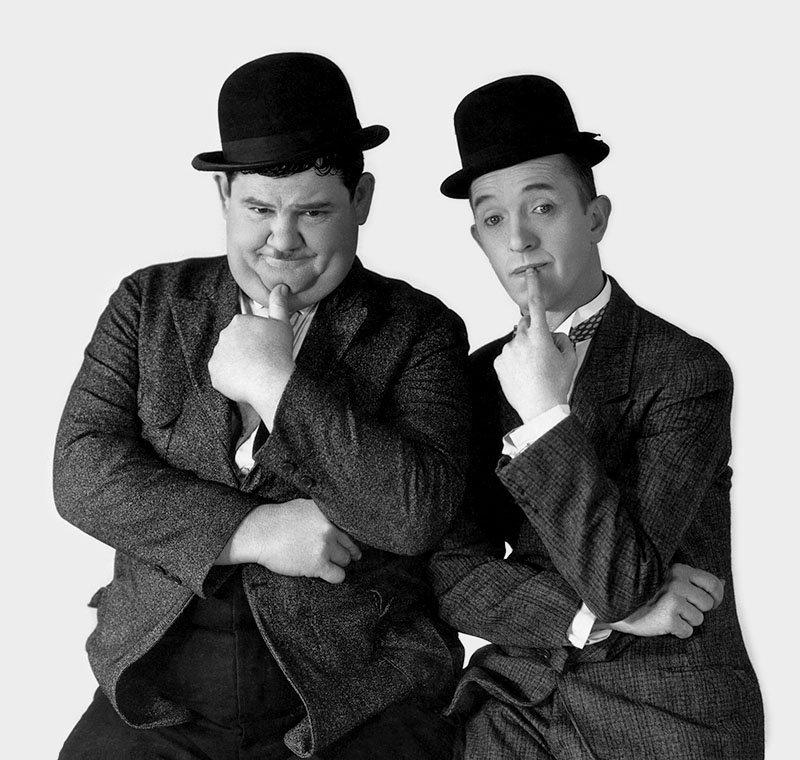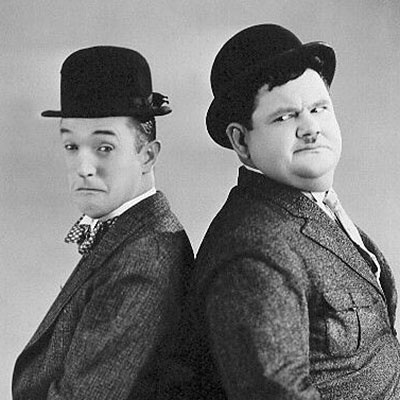1930 Letters

Sorry, the Stan Laurel Correspondence Archive Project has no letters from this month and year. Even Stan and Ollie are perplexed. If you have an original letter from Stan or have a copy not included in these Archives, please add a copy of your letter by contacting us via e-mail at info@lettersfromstan.com

By Dorothy Spensley
Three and a half years ago Stan Laurel and Oliver “Babe” Hardy were just a couple of bright boys knocking about Mr. Hal Roach’s studio. Today the world is laughing at them. They are billed over feature pictures with sex appeal heroines in theater electrics. They are inserted in initial talkies of grand opera baritones. This, to their regret.
They are the comedy sensations of the season.
And all because they have learned, by a lucky stroke, that the public likes to see itself caricatured on the screen; that the public can laugh at the meanderings of a fat man who shakes a warning pudgy forefinger at a sensitive simpleton who is prone to weep.
They must be a success because they are waylaid for autographs. They are asked to talk over the radio. Festive nights are given for them at leading hotels. Fans, loitering in preview theater lobbies, sidle up and ask Stan to cry. Cry like he does in pictures.
“And I don’t like to cry,” said Stan, wrinkling his nose over the baked barracuda.
“There, there! You won't have to cry.”
Babe looked relieved, because he was in on this, too. He had laryngitis, and was eating chocolate ice cream for it.
“I don’t like to cry,” said Stan, smiling bravely as he forked the barracuda.
And you won’t have to, or we’ll know the reason why, won’t we, Oliver? But Oliver was folding the rich yellow blobs of a pitcher of cream into the dark loam of the ice cream. He weighs well over two hundred and fifty, and his middle name is Norvell. He was reared to be an attorney, in Atlanta, Georgia.
And he’s married.
Oliver is the punctilious gentleman of the comedies; the dainty, particular dear who is social mentor for Stan. You’ve noticed it in their thirty-two comedies. He is the one who gently chides Stan when Stan does the wrong thing. He is the exasperated darling who puffs his cheeks and looks long and hard at Stan when, say, he drops the eclair down the hostess’ back.
But Stan is the one who whimpers. He is the one who crescents his brows, blinks his eyes, gulps, draws his lips into a quivering, wounded slit, and weeps. He is the underdog with the lachrymose pan.
To us, he will always be Whimpering Stan. Everywhere he goes they ask him to weep. That’s why he doesn’t like to cry. Even when he goes home at night, Lois, his four-year-old, meets him at the gate with a request for daddy to weep. His wife has laughed at his whining pan for six years.
Oliver drives a sportive coupe, and Stan a Ford. But when Stan takes the family out on a Sunday it’s in a Pierce-Arrow.
Who thinks of the gags?
‘We both do,” says Whimpering Stan, grinning.
“We both do,” says Punctilious Oliver, soberly.
It takes three men to make the Laurel and Hardy comedies. Stan writes the skeleton story and takes it to the set where Jim Parrot, director, brother of Charlie Chase, another Roach comedian, and Oliver, go into a huddle.
The laugh-getting gags are worked out as they shoot. It takes seven days to make a comedy that must elicit seventy-five laughs. They count the laughs at previews. That’s what they call “clocking” a comedy. If it “clocks” less than that, something is wrong. One comedy brought one hundred and twenty laughs. A record. The comedies are usually two-reels. If they sustain the laugh interest, they are allowed to run two and a half or three.
What does the public laugh at? Homely situations, mostly. Everyday occurrences. Consider “A Perfect Day.” It’s built on the simple situation of a family preparing for a picnic, packing the basket, assisting gouty uncle to the balky Ford. “Night Owls” is not built so much on the antics of thieves, but rather the utter idiocy of two humans trying to enter a house without a key. Ordinary stuff. Everyday situations, but etched by comedy hands; seen through the merry squint of comedy eyes.
Whimpering Stan has more to do with the comedies than he reticently admits, it is said. It is he who plants the seed of the story and watches it bloom into something funny. A man of about forty, with blond hair and live blue eyes, he has plenty of stage experience.
He’s a Lancashire lad, born in Ulverston, England, of professional parents. His childhood was spent in the music halls. In 1910 he came to America with Fred Karno’s London Comedians. Charles Chaplin was in the troupe. Stan understudied him, and when Charlie left to go into pictures, Stan stepped into his oversized shoes. Like Chaplin, he realizes that a laugh is close to a tear, and he sprinkles his stories with the faintest suggestion of pathos.
That bristling pompadour of Whimpering Stan was arrived at by accident. He had played in a convict picture and so had Babe.
Both had shaved their heads. At the end of the picture Stan sailed for England and Oliver went vacationing. When Stan returned his hair covered his head like a porcupine's thatch. Roach saw it and that was the beginning of Stan’s stylish bob.
They roister about the lot, Babe and Stan, sometimes clowning for favored visitors. Babe sings, and Stan plays the piano. They have no desire to make feature length pictures unless they find a sure-fire story. They have seen too many comedy teams hit the rocks in seven-reel specials.
—Photoplay
July 1930

